Bulan Satelit bumi
BULAN
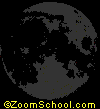 The moon is Earth's only natural satellite. Bulan ini Bumi hanya satelit alami. The moon is a cold, dry orb whose surface is studded with craters and strewn with rocks and dust (called regolith ). Bulan adalah bola, dingin kering yang dihiasi dengan permukaan kawah dan berserakan dengan batu dan debu (disebut regolith ). The moon has no atmosphere. Bulan tidak memiliki atmosfer. Recent lunar missions indicate that there might be some frozen ice at the poles . Misi bulan terakhir menunjukkan bahwa mungkin ada es beku di kutub .
The moon is Earth's only natural satellite. Bulan ini Bumi hanya satelit alami. The moon is a cold, dry orb whose surface is studded with craters and strewn with rocks and dust (called regolith ). Bulan adalah bola, dingin kering yang dihiasi dengan permukaan kawah dan berserakan dengan batu dan debu (disebut regolith ). The moon has no atmosphere. Bulan tidak memiliki atmosfer. Recent lunar missions indicate that there might be some frozen ice at the poles . Misi bulan terakhir menunjukkan bahwa mungkin ada es beku di kutub .
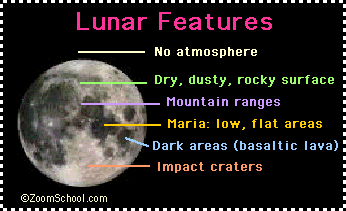 The same side of the moon always faces the Earth. Sisi yang sama dari bulan selalu menghadap Bumi. The
far side of the moon was first observed by humans in 1959 when the
unmanned Soviet Luna 3 mission orbited the moon and photographed it. Neil Armstrong
and Buzz Aldrin (on NASA's Apollo 11 mission, which also included
Michael Collins) were the first people to walk on the moon, on July 20,
1969. Sisi jauh bulan pertama kali
diamati oleh manusia pada tahun 1959 ketika Uni Soviet tak berawak Luna
3 misi mengorbit bulan dan difoto itu. Neil Armstrong
dan Buzz Aldrin (di 11 misi Apollo NASA, yang juga termasuk Michael
Collins) adalah orang pertama yang berjalan di bulan, pada tanggal 20
Juli 1969.
The same side of the moon always faces the Earth. Sisi yang sama dari bulan selalu menghadap Bumi. The
far side of the moon was first observed by humans in 1959 when the
unmanned Soviet Luna 3 mission orbited the moon and photographed it. Neil Armstrong
and Buzz Aldrin (on NASA's Apollo 11 mission, which also included
Michael Collins) were the first people to walk on the moon, on July 20,
1969. Sisi jauh bulan pertama kali
diamati oleh manusia pada tahun 1959 ketika Uni Soviet tak berawak Luna
3 misi mengorbit bulan dan difoto itu. Neil Armstrong
dan Buzz Aldrin (di 11 misi Apollo NASA, yang juga termasuk Michael
Collins) adalah orang pertama yang berjalan di bulan, pada tanggal 20
Juli 1969.
 If you were standing on the moon, the sky would always appear dark, even during the daytime. Jika Anda berdiri di bulan, langit akan selalu tampak gelap, bahkan selama siang hari. Also, from any spot on the moon (except on the far side of the moon where you cannot see the Earth), the Earth
would always be in the same place in the sky; the phase of the Earth
changes and the Earth rotates, displaying various continents. Juga, dari setiap titik di bulan (kecuali pada sisi jauh bulan di mana Anda tidak dapat melihat Bumi), yang bumi akan selalu di tempat yang sama di langit; fase perubahan Bumi dan Bumi berputar, menampilkan berbagai benua.
If you were standing on the moon, the sky would always appear dark, even during the daytime. Jika Anda berdiri di bulan, langit akan selalu tampak gelap, bahkan selama siang hari. Also, from any spot on the moon (except on the far side of the moon where you cannot see the Earth), the Earth
would always be in the same place in the sky; the phase of the Earth
changes and the Earth rotates, displaying various continents. Juga, dari setiap titik di bulan (kecuali pada sisi jauh bulan di mana Anda tidak dapat melihat Bumi), yang bumi akan selalu di tempat yang sama di langit; fase perubahan Bumi dan Bumi berputar, menampilkan berbagai benua.
THE MOON'S ORBIT Bulan ORBIT

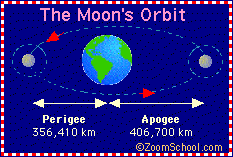 The moon is about 238,900 miles (384,000 km) from Earth on average. Bulan adalah sekitar 238.900 mil (384.000 km) dari Bumi rata-rata. At its closest approach (the lunar perigee ) the moon is 221,460 miles (356,410 km) from the Earth. Pada pendekatan terdekat (yang perigee bulan ) bulan adalah 221.460 mil (356.410 km) dari Bumi. At its farthest approach (its apogee) the moon is 252,700 miles (406,700 km) from the Earth. Pada pendekatan terjauh (puncaknya) bulan adalah 252.700 mil (406.700 km) dari Bumi.
The moon is about 238,900 miles (384,000 km) from Earth on average. Bulan adalah sekitar 238.900 mil (384.000 km) dari Bumi rata-rata. At its closest approach (the lunar perigee ) the moon is 221,460 miles (356,410 km) from the Earth. Pada pendekatan terdekat (yang perigee bulan ) bulan adalah 221.460 mil (356.410 km) dari Bumi. At its farthest approach (its apogee) the moon is 252,700 miles (406,700 km) from the Earth. Pada pendekatan terjauh (puncaknya) bulan adalah 252.700 mil (406.700 km) dari Bumi.
The moon revolves around the Earth in about one month (27 days 8 hours). Bulan berputar mengelilingi bumi dalam waktu sekitar satu bulan (27 hari 8 jam). It rotates around its own axis in the same amount of time. Berputar mengelilingi porosnya sendiri dalam jumlah waktu yang sama. The same side of the moon always faces the Earth; it is in a synchronous rotation with the Earth. Sisi yang sama dari bulan selalu menghadap bumi, melainkan berada dalam rotasi sinkron dengan Bumi.
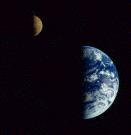 The Moon's orbit is expanding over time as it slows down (the Earth is also slowing down as it loses energy). Orbit Bulan adalah memperluas dari waktu ke waktu karena memperlambat bawah (bumi juga melambat seperti kehilangan energi). For
example, a billion years ago, the Moon was much closer to the Earth
(roughly 200,000 kilometers) and took only 20 days to orbit the Earth. Sebagai
contoh, satu miliar tahun lalu, Bulan jauh lebih dekat dengan Bumi
(sekitar 200.000 kilometer) dan mengambil hanya 20 hari untuk mengorbit
Bumi. Also, one Earth 'day' was about 18 hours long (instead of our 24 hour day). Juga, salah satu 'hari' Bumi sekitar 18 jam yang panjang (bukan hari 24 jam kami). The tides on Earth were also much stronger since the moon was closer to the Earth. Pasang surut di Bumi juga jauh lebih kuat sejak bulan lebih dekat ke Bumi.
The Moon's orbit is expanding over time as it slows down (the Earth is also slowing down as it loses energy). Orbit Bulan adalah memperluas dari waktu ke waktu karena memperlambat bawah (bumi juga melambat seperti kehilangan energi). For
example, a billion years ago, the Moon was much closer to the Earth
(roughly 200,000 kilometers) and took only 20 days to orbit the Earth. Sebagai
contoh, satu miliar tahun lalu, Bulan jauh lebih dekat dengan Bumi
(sekitar 200.000 kilometer) dan mengambil hanya 20 hari untuk mengorbit
Bumi. Also, one Earth 'day' was about 18 hours long (instead of our 24 hour day). Juga, salah satu 'hari' Bumi sekitar 18 jam yang panjang (bukan hari 24 jam kami). The tides on Earth were also much stronger since the moon was closer to the Earth. Pasang surut di Bumi juga jauh lebih kuat sejak bulan lebih dekat ke Bumi.
SAROS Saros
The saros is the roughly 18-year periodic cycle of the Earth-Moon-Sun system. Para saros adalah siklus periodik sekitar 18-tahun sistem Bumi-Bulan-Matahari. Every 6,585 days, the Earth, Moon and Sun are in exactly the same position. Setiap 6.585 hari, Bumi, Bulan dan Matahari berada di posisi yang sama persis. When there is a lunar eclipse, there will also be one exactly 6,585 days later. Ketika ada gerhana bulan, ada juga akan menjadi salah tepatnya 6.585 hari kemudian.
SIZE UKURAN
 The moon's diameter is 2,140 miles (3,476 km), 27% of the diameter of the Earth (a bit over a quarter of the Earth's diameter). Diameter Bulan adalah 2.140 mil (3.476 km), 27% dari diameter Bumi (sedikit lebih dari seperempat diameter Bumi).
The moon's diameter is 2,140 miles (3,476 km), 27% of the diameter of the Earth (a bit over a quarter of the Earth's diameter). Diameter Bulan adalah 2.140 mil (3.476 km), 27% dari diameter Bumi (sedikit lebih dari seperempat diameter Bumi).
The gravitational tidal influence of the Moon on the Earth is about twice as strong as the Sun's gravitational tidal influence. Pengaruh pasang surut gravitasi Bulan di Bumi adalah sekitar dua kali lebih kuat sebagai Sun pengaruh gravitasi pasang surut. The Earth:moon size ratio is quite small in comparison to ratios of most other planet:moon systems (for most planets in our Solar System, the moons are much smaller in comparison to the planet and have less of an effect on the planet). Bumi: Bulan rasio ukuran cukup kecil dibandingkan dengan rasio yang paling planet lain: sistem bulan (untuk sebagian besar planet-planet di Tata Surya kita, bulan jauh lebih kecil dibandingkan dengan planet dan memiliki kurang dari efek pada planet ini).
MASS AND GRAVITY MASSA DAN GRAVITASI
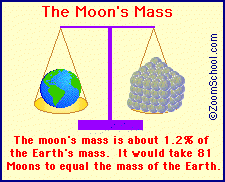 The moon's mass is (7.35 x 10 22 kg), about 1/81 of the Earth's mass. Massa bulan adalah (7,35 x 10 22 kg), sekitar 1 / 81 massa Bumi.
The moon's mass is (7.35 x 10 22 kg), about 1/81 of the Earth's mass. Massa bulan adalah (7,35 x 10 22 kg), sekitar 1 / 81 massa Bumi.
The moon's gravitational force is only 17% of the Earth's gravity. Gaya gravitasi bulan hanya 17% dari gravitasi bumi. For example, a 100 pound (45 kg) person would weigh only 17 pounds (7.6 kg) on the Moon. Sebagai contoh, satu pon 100 (45 kg) orang akan berat hanya 17 pon (7,6 kg) di Bulan.
The moon's density is 3340 kg/m 3 . Kepadatan bulan adalah 3340 kg / m 3. This is about 3/5 the density of the Earth. Ini adalah sekitar 3 / 5 kepadatan Bumi.
 TEMPERATURE SUHU
TEMPERATURE SUHU
The temperature on the Moon ranges from daytime highs of about 130°C = 265°F to nighttime lows of about -110°C = -170°F Suhu di Bulan di siang hari berkisar dari tertinggi sekitar 130 ° C = 265 ° F ke posisi terendah malam hari sekitar -110 ° C = -170 ° F
ATMOSPHERE ATMOSFIR
The moon has no atmosphere. Bulan tidak memiliki atmosfer. On the moon, the sky is always appears dark, even on the bright side (because there is no atmosphere). Di bulan, langit tampak gelap selalu, bahkan pada sisi terang (karena tidak ada atmosfer). Also, since sound waves travel through air, the moon is silent; there can be no sound transmission on the moon. Juga, karena perjalanan gelombang suara melalui udara, bulan adalah diam, tidak akan ada transmisi suara di bulan.
MARE MARE
 Mare (plural maria) means "sea," but maria on the moon are plains on the moon. Mare (jamak maria) berarti "laut," tapi maria di bulan adalah dataran di bulan. They are called maria because very early astronomers thought that these areas on the moon were great seas. Mereka disebut maria karena para astronom sangat dini berpikir bahwa daerah-daerah di bulan itu lautan besar. The first moon landing was in the Mare Tranquillitatis (the Sea of Tranquility). Pendaratan di bulan pertama di Tranquillitatis Mare (Laut Ketenangan). Maria are concentrated on the side of the moon that faces the Earth; the far side has very few of these plains. Maria terkonsentrasi di sisi bulan yang menghadap bumi; sisi jauh memiliki sangat sedikit dari dataran. Scientists don't know why this is so. Para ilmuwan tidak tahu mengapa demikian.
Mare (plural maria) means "sea," but maria on the moon are plains on the moon. Mare (jamak maria) berarti "laut," tapi maria di bulan adalah dataran di bulan. They are called maria because very early astronomers thought that these areas on the moon were great seas. Mereka disebut maria karena para astronom sangat dini berpikir bahwa daerah-daerah di bulan itu lautan besar. The first moon landing was in the Mare Tranquillitatis (the Sea of Tranquility). Pendaratan di bulan pertama di Tranquillitatis Mare (Laut Ketenangan). Maria are concentrated on the side of the moon that faces the Earth; the far side has very few of these plains. Maria terkonsentrasi di sisi bulan yang menghadap bumi; sisi jauh memiliki sangat sedikit dari dataran. Scientists don't know why this is so. Para ilmuwan tidak tahu mengapa demikian.
CRATERS AND RILLES Kawah dan RILLES
The surface of the moon is scarred by millions of (mostly circular) impact craters, caused by asteroids, comets, and meteorites. Permukaan bulan yang terluka oleh jutaan (kebanyakan melingkar) kawah, yang disebabkan oleh asteroid, komet, dan meteorit. There
is no atmosphere on the moon to help protect it from bombardment from
potential impactors (most objects from space burn up in our atmosphere).
Tidak ada atmosfer di bulan untuk membantu melindungi dari pengeboman
dari penabrak potensial (objek yang paling dari luar angkasa terbakar
di atmosfer kita). Also,
there is no erosion (wind or precipitation) and little geologic
activity to wear away these craters, so they remain unchanged until
another new impact changes it. Juga, tidak ada erosi (angin atau
curah hujan) dan aktivitas geologi sedikit hilang kawah ini, sehingga
mereka tetap tidak berubah sampai lain dampak perubahan baru itu.
These craters range in size up to many hundreds of kilometers, but the most enormous craters have been flooded by lava, and only parts of the outline are visible. Ini berkisar kawah dalam ukuran sampai dengan ratusan kilometer, tetapi kawah yang paling besar telah dibanjiri oleh lava, dan hanya bagian dari garis yang terlihat. The low elevation maria (seas) have fewer craters than other areas. Elevasi rendah maria (laut) memiliki kawah kurang dari daerah lain. This is because these areas formed more recently, and have had less time to be hit. Hal ini karena daerah ini terbentuk baru-baru ini, dan memiliki sedikit waktu untuk menjadi hit. The biggest intact lunar crater is Clavius which is 100 miles (160 km) in diameter. Kawah terbesar utuh lunar Clavius yang 100 mil (160 km) dalam diameter.
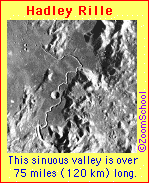 A rille is a long, narrow valley on the surface of the moon. Sebuah rille adalah sebuah lembah, panjang dan sempit pada permukaan bulan. Hadley Rille is a long valley on the surface of the moon. Hadley Rille adalah sebuah lembah panjang di permukaan bulan. This rille is 75 miles (125 km) long, 1300 feet (400 m) deep, and almost 1 mile (1500 m) wide at its widest point. Ini rille adalah 75 mil (125 km) panjang, 1300 kaki (400 m) yang mendalam, dan hampir 1 mil (1500 m) lebar pada titik terlebar. It
was formed by molten basaltic lava that carved out a steep channel
along the base of the Apennine Front (which was explored by the Apollo
15 astronauts in 1971). Ini dibentuk oleh lava basaltik cair
yang diukir saluran curam sepanjang dasar dari Front Apennine (yang
dieksplorasi oleh astronot Apollo 15 pada tahun 1971).
A rille is a long, narrow valley on the surface of the moon. Sebuah rille adalah sebuah lembah, panjang dan sempit pada permukaan bulan. Hadley Rille is a long valley on the surface of the moon. Hadley Rille adalah sebuah lembah panjang di permukaan bulan. This rille is 75 miles (125 km) long, 1300 feet (400 m) deep, and almost 1 mile (1500 m) wide at its widest point. Ini rille adalah 75 mil (125 km) panjang, 1300 kaki (400 m) yang mendalam, dan hampir 1 mil (1500 m) lebar pada titik terlebar. It
was formed by molten basaltic lava that carved out a steep channel
along the base of the Apennine Front (which was explored by the Apollo
15 astronauts in 1971). Ini dibentuk oleh lava basaltik cair
yang diukir saluran curam sepanjang dasar dari Front Apennine (yang
dieksplorasi oleh astronot Apollo 15 pada tahun 1971).
MOON OR DOUBLE PLANET? BULAN ATAU PLANET DOUBLE?
The Earth and the Moon are relatively close in size (4:1 in diameter, 81:1 in mass), unlike most planet/moon systems. Bumi dan Bulan relatif dekat dalam ukuran (4:1 diameter, 81:1 massa), tidak seperti kebanyakan planet / bulan sistem. Many people consider the Earth and Moon to be a double planet system (rather than a planet/moon system). Banyak orang menganggap Bumi dan Bulan menjadi sebuah sistem planet ganda (daripada sistem planet / bulan). The moon does not actually revolve around the Earth; it revolves around the Sun in concert with the Earth (like a double planet system). Bulan tidak benar-benar berputar di sekitar bumi, berputar mengelilingi matahari dalam konser dengan Bumi (seperti sistem planet ganda).
LIBRATION LIBRATION
Libration is a rocking movement of the Moon . Libration adalah gerakan goyang dari Bulan . Librations cause us to view the Moon from different angles at different times, enabling us to see about 59 percent of the Moon's surface from Earth , even though the same side always faces us. Librations menyebabkan kita untuk melihat Bulan dari sudut yang berbeda pada waktu yang berbeda, memungkinkan kita untuk melihat sekitar 59 persen dari permukaan Bulan dari Bumi , meskipun sisi yang sama selalu menghadap kita. There are librations due to variations in the rate of the Moon's orbital motion (longitudinal libration) and to the inclination of the Moon's equator with respect to its orbital plane (latitudinal libration). Ada librations karena variasi dalam tingkat gerak orbit Bulan (libration longitudinal) dan kecenderungan khatulistiwa Bulan sehubungan dengan bidang orbitnya (libration garis lintang). There is also an apparent libration due to an observer on Earth viewing the Moon from different angles as the Earth rotates (diurnal libration, which occurs each day). Ada juga libration jelas karena seorang pengamat di Bumi melihat Bulan dari sudut yang berbeda seperti bumi berputar (libration diurnal, yang terjadi setiap hari). TWO LUNAR MONTHS DUA BULAN LUNAR
The sidereal and synodic lunar months have different lengths. Bulan-bulan bulan sidereal dan synodic memiliki panjang yang berbeda. The sidereal month is the amount of time it takes the Moon to return to the same position in the sky with respect to the stars; the sidereal month is 27.321 days long. Bulan sidereal adalah jumlah waktu yang dibutuhkan Bulan untuk kembali ke posisi yang sama di langit sehubungan dengan bintang-bintang; bulan sidereal adalah 27,321 hari panjang. The synodic month is the time between similar lunar phases (eg, between two full moons); the synodic month is 29.530 days long. Bulan synodic adalah waktu antara fase lunar serupa (misalnya, antara dua bulan purnama); bulan synodic adalah 29,530 hari panjang.
LUNAR EXPLORATION EKSPLORASI LUNAR
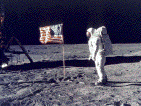 There have been many missions to the moon, including orbiters missions and moon landings. Ada banyak misi ke bulan, termasuk misi dan pendaratan pengorbit bulan. NASA's Apollo missions sent people to the moon for the first time. NASA misi Apollo mengirim orang ke bulan untuk pertama kalinya. Apollo
11's LEM (Lunar Excursion Module) landed on the moon on July 20, 1969
with Neil Armstrong and Edwin "Buzz" Aldrin (Michael Collins was in the
orbiter). Apollo 11 yang LEM (Lunar Modul Ekskursi) mendarat di
bulan pada 20 Juli 1969 dengan Neil Armstrong dan Edwin "Buzz" Aldrin
(Michael Collins berada di pengorbit). Neil Armstrong was the first person to set foot on the moon. Neil Amstrong adalah orang pertama yang menginjakkan kaki di bulan. His
first words upon stepping down the Lunar Module's ladder onto the lunar
surface were, "That's one small step for man, one giant leap for
mankind." Kata-kata pertamanya setelah melangkah menuruni tangga
Lunar Module ini ke permukaan bulan itu, "Itu salah satu langkah kecil
bagi orang, satu lompatan raksasa bagi umat manusia." Aldrin described the lunar scenery as "magnificent desolation." Aldrin menggambarkan pemandangan lunar sebagai "kehancuran luar biasa." Apollo 12-17 continued lunar exploration. Apollo 12-17 melanjutkan eksplorasi bulan.
There have been many missions to the moon, including orbiters missions and moon landings. Ada banyak misi ke bulan, termasuk misi dan pendaratan pengorbit bulan. NASA's Apollo missions sent people to the moon for the first time. NASA misi Apollo mengirim orang ke bulan untuk pertama kalinya. Apollo
11's LEM (Lunar Excursion Module) landed on the moon on July 20, 1969
with Neil Armstrong and Edwin "Buzz" Aldrin (Michael Collins was in the
orbiter). Apollo 11 yang LEM (Lunar Modul Ekskursi) mendarat di
bulan pada 20 Juli 1969 dengan Neil Armstrong dan Edwin "Buzz" Aldrin
(Michael Collins berada di pengorbit). Neil Armstrong was the first person to set foot on the moon. Neil Amstrong adalah orang pertama yang menginjakkan kaki di bulan. His
first words upon stepping down the Lunar Module's ladder onto the lunar
surface were, "That's one small step for man, one giant leap for
mankind." Kata-kata pertamanya setelah melangkah menuruni tangga
Lunar Module ini ke permukaan bulan itu, "Itu salah satu langkah kecil
bagi orang, satu lompatan raksasa bagi umat manusia." Aldrin described the lunar scenery as "magnificent desolation." Aldrin menggambarkan pemandangan lunar sebagai "kehancuran luar biasa." Apollo 12-17 continued lunar exploration. Apollo 12-17 melanjutkan eksplorasi bulan.
MOON ROCKS MOON ROCKS
 NASA astronauts have retrieved 842 pounds (382 kg) of moon rocks (in many missions), which have been closely studied. Astronot NASA telah diambil £ 842 (382 kg) dari batuan bulan (dalam banyak misi), yang telah erat dipelajari. The composition of the moon rocks is very similar to that of Earth rocks. Komposisi dari batuan bulan adalah sangat mirip dengan batuan Bumi. Using radioisotope dating, it has been found that moon rocks are about 4.3 billion years old. Menggunakan radioisotop kencan, telah ditemukan bahwa batuan bulan yang sekitar 4,3 miliar tahun.
NASA astronauts have retrieved 842 pounds (382 kg) of moon rocks (in many missions), which have been closely studied. Astronot NASA telah diambil £ 842 (382 kg) dari batuan bulan (dalam banyak misi), yang telah erat dipelajari. The composition of the moon rocks is very similar to that of Earth rocks. Komposisi dari batuan bulan adalah sangat mirip dengan batuan Bumi. Using radioisotope dating, it has been found that moon rocks are about 4.3 billion years old. Menggunakan radioisotop kencan, telah ditemukan bahwa batuan bulan yang sekitar 4,3 miliar tahun.
THE ORIGIN OF THE MOON ASAL DARI BULAN
Most scientists believe that the moon was formed from the ejected material after the Earth collided with a Mars-sized object. Kebanyakan ilmuwan percaya bahwa bulan terbentuk dari bahan dikeluarkan setelah Bumi bertabrakan dengan benda seukuran Mars. This ejected material coalesced into the moon that went into orbit around th Earth. Bahan ini dikeluarkan berkoalisi menjadi bulan yang masuk ke orbit sekitar Bumi th. This catastrophic collision occurred about 60 million years after Earth itself formed (about 4.3 billion years ago). Ini terjadi tabrakan katastropik sekitar 60 juta tahun setelah bumi terbentuk sendiri (sekitar 4,3 milyar tahun lalu). This is determined by the radioisotope dating of moon rocks Hal ini ditentukan oleh penanggalan radioisotop batuan bulan
BLUE MOON BIRU MOON


When two full moons occur in a single month, the second full moon is called a "Blue Moon." Ketika dua bulan penuh terjadi dalam satu bulan, bulan purnama kedua disebut "Blue Moon." Another definition of the blue moon is the third full moon that occurs in a season of the year which has four full moons (usually each season has only three full moons.) Definisi lain dari bulan biru adalah bulan purnama ketiga yang terjadi dalam musim tahun yang memiliki empat bulan penuh (biasanya setiap musim hanya memiliki tiga bulan penuh.)
 The moon is Earth's only natural satellite. Bulan ini Bumi hanya satelit alami. The moon is a cold, dry orb whose surface is studded with craters and strewn with rocks and dust (called regolith ). Bulan adalah bola, dingin kering yang dihiasi dengan permukaan kawah dan berserakan dengan batu dan debu (disebut regolith ). The moon has no atmosphere. Bulan tidak memiliki atmosfer. Recent lunar missions indicate that there might be some frozen ice at the poles . Misi bulan terakhir menunjukkan bahwa mungkin ada es beku di kutub .
The moon is Earth's only natural satellite. Bulan ini Bumi hanya satelit alami. The moon is a cold, dry orb whose surface is studded with craters and strewn with rocks and dust (called regolith ). Bulan adalah bola, dingin kering yang dihiasi dengan permukaan kawah dan berserakan dengan batu dan debu (disebut regolith ). The moon has no atmosphere. Bulan tidak memiliki atmosfer. Recent lunar missions indicate that there might be some frozen ice at the poles . Misi bulan terakhir menunjukkan bahwa mungkin ada es beku di kutub . THE MOON'S ORBIT Bulan ORBIT
The moon revolves around the Earth in about one month (27 days 8 hours). Bulan berputar mengelilingi bumi dalam waktu sekitar satu bulan (27 hari 8 jam). It rotates around its own axis in the same amount of time. Berputar mengelilingi porosnya sendiri dalam jumlah waktu yang sama. The same side of the moon always faces the Earth; it is in a synchronous rotation with the Earth. Sisi yang sama dari bulan selalu menghadap bumi, melainkan berada dalam rotasi sinkron dengan Bumi.
SAROS Saros
The saros is the roughly 18-year periodic cycle of the Earth-Moon-Sun system. Para saros adalah siklus periodik sekitar 18-tahun sistem Bumi-Bulan-Matahari. Every 6,585 days, the Earth, Moon and Sun are in exactly the same position. Setiap 6.585 hari, Bumi, Bulan dan Matahari berada di posisi yang sama persis. When there is a lunar eclipse, there will also be one exactly 6,585 days later. Ketika ada gerhana bulan, ada juga akan menjadi salah tepatnya 6.585 hari kemudian.
SIZE UKURAN
The gravitational tidal influence of the Moon on the Earth is about twice as strong as the Sun's gravitational tidal influence. Pengaruh pasang surut gravitasi Bulan di Bumi adalah sekitar dua kali lebih kuat sebagai Sun pengaruh gravitasi pasang surut. The Earth:moon size ratio is quite small in comparison to ratios of most other planet:moon systems (for most planets in our Solar System, the moons are much smaller in comparison to the planet and have less of an effect on the planet). Bumi: Bulan rasio ukuran cukup kecil dibandingkan dengan rasio yang paling planet lain: sistem bulan (untuk sebagian besar planet-planet di Tata Surya kita, bulan jauh lebih kecil dibandingkan dengan planet dan memiliki kurang dari efek pada planet ini).
MASS AND GRAVITY MASSA DAN GRAVITASI
The moon's gravitational force is only 17% of the Earth's gravity. Gaya gravitasi bulan hanya 17% dari gravitasi bumi. For example, a 100 pound (45 kg) person would weigh only 17 pounds (7.6 kg) on the Moon. Sebagai contoh, satu pon 100 (45 kg) orang akan berat hanya 17 pon (7,6 kg) di Bulan.
The moon's density is 3340 kg/m 3 . Kepadatan bulan adalah 3340 kg / m 3. This is about 3/5 the density of the Earth. Ini adalah sekitar 3 / 5 kepadatan Bumi.
The temperature on the Moon ranges from daytime highs of about 130°C = 265°F to nighttime lows of about -110°C = -170°F Suhu di Bulan di siang hari berkisar dari tertinggi sekitar 130 ° C = 265 ° F ke posisi terendah malam hari sekitar -110 ° C = -170 ° F
ATMOSPHERE ATMOSFIR
The moon has no atmosphere. Bulan tidak memiliki atmosfer. On the moon, the sky is always appears dark, even on the bright side (because there is no atmosphere). Di bulan, langit tampak gelap selalu, bahkan pada sisi terang (karena tidak ada atmosfer). Also, since sound waves travel through air, the moon is silent; there can be no sound transmission on the moon. Juga, karena perjalanan gelombang suara melalui udara, bulan adalah diam, tidak akan ada transmisi suara di bulan.
MARE MARE
CRATERS AND RILLES Kawah dan RILLES
The lunar crater Aristarchus ( on the NW edge of the Oceanus Procellarum). Lunar kawah Aristarchus (di tepi NW dari Procellarum Oceanus). This huge, circular crater is 25 miles (40 km) in diameter and 2.2 miles (3.6 km) deep (from rim to floor). Ini kawah, besar melingkar adalah 25 mil (40 km) dalam diameter dan 2,2 mil (3,6 km) dalam (dari RIM ke lantai). There is a lot of ejecta (material thrown from the crater at impact) surrounding the crater. Ada banyak ejecta (bahan dilemparkan dari kawah pada dampak) yang mengelilingi kawah. |
These craters range in size up to many hundreds of kilometers, but the most enormous craters have been flooded by lava, and only parts of the outline are visible. Ini berkisar kawah dalam ukuran sampai dengan ratusan kilometer, tetapi kawah yang paling besar telah dibanjiri oleh lava, dan hanya bagian dari garis yang terlihat. The low elevation maria (seas) have fewer craters than other areas. Elevasi rendah maria (laut) memiliki kawah kurang dari daerah lain. This is because these areas formed more recently, and have had less time to be hit. Hal ini karena daerah ini terbentuk baru-baru ini, dan memiliki sedikit waktu untuk menjadi hit. The biggest intact lunar crater is Clavius which is 100 miles (160 km) in diameter. Kawah terbesar utuh lunar Clavius yang 100 mil (160 km) dalam diameter.
MOON OR DOUBLE PLANET? BULAN ATAU PLANET DOUBLE?
The Earth and the Moon are relatively close in size (4:1 in diameter, 81:1 in mass), unlike most planet/moon systems. Bumi dan Bulan relatif dekat dalam ukuran (4:1 diameter, 81:1 massa), tidak seperti kebanyakan planet / bulan sistem. Many people consider the Earth and Moon to be a double planet system (rather than a planet/moon system). Banyak orang menganggap Bumi dan Bulan menjadi sebuah sistem planet ganda (daripada sistem planet / bulan). The moon does not actually revolve around the Earth; it revolves around the Sun in concert with the Earth (like a double planet system). Bulan tidak benar-benar berputar di sekitar bumi, berputar mengelilingi matahari dalam konser dengan Bumi (seperti sistem planet ganda).
LIBRATION LIBRATION
Libration is a rocking movement of the Moon . Libration adalah gerakan goyang dari Bulan . Librations cause us to view the Moon from different angles at different times, enabling us to see about 59 percent of the Moon's surface from Earth , even though the same side always faces us. Librations menyebabkan kita untuk melihat Bulan dari sudut yang berbeda pada waktu yang berbeda, memungkinkan kita untuk melihat sekitar 59 persen dari permukaan Bulan dari Bumi , meskipun sisi yang sama selalu menghadap kita. There are librations due to variations in the rate of the Moon's orbital motion (longitudinal libration) and to the inclination of the Moon's equator with respect to its orbital plane (latitudinal libration). Ada librations karena variasi dalam tingkat gerak orbit Bulan (libration longitudinal) dan kecenderungan khatulistiwa Bulan sehubungan dengan bidang orbitnya (libration garis lintang). There is also an apparent libration due to an observer on Earth viewing the Moon from different angles as the Earth rotates (diurnal libration, which occurs each day). Ada juga libration jelas karena seorang pengamat di Bumi melihat Bulan dari sudut yang berbeda seperti bumi berputar (libration diurnal, yang terjadi setiap hari). TWO LUNAR MONTHS DUA BULAN LUNAR
The sidereal and synodic lunar months have different lengths. Bulan-bulan bulan sidereal dan synodic memiliki panjang yang berbeda. The sidereal month is the amount of time it takes the Moon to return to the same position in the sky with respect to the stars; the sidereal month is 27.321 days long. Bulan sidereal adalah jumlah waktu yang dibutuhkan Bulan untuk kembali ke posisi yang sama di langit sehubungan dengan bintang-bintang; bulan sidereal adalah 27,321 hari panjang. The synodic month is the time between similar lunar phases (eg, between two full moons); the synodic month is 29.530 days long. Bulan synodic adalah waktu antara fase lunar serupa (misalnya, antara dua bulan purnama); bulan synodic adalah 29,530 hari panjang.
LUNAR EXPLORATION EKSPLORASI LUNAR
Astronaut Buzz Aldrin's footprint on the moon's Sea of Tranquility, from the Apollo 11 mission in 1969. Astronaut Buzz Aldrin yang jejak di Laut bulan Tranquility, dari misi Apollo 11 pada tahun 1969. |
MOON ROCKS MOON ROCKS
THE ORIGIN OF THE MOON ASAL DARI BULAN
Most scientists believe that the moon was formed from the ejected material after the Earth collided with a Mars-sized object. Kebanyakan ilmuwan percaya bahwa bulan terbentuk dari bahan dikeluarkan setelah Bumi bertabrakan dengan benda seukuran Mars. This ejected material coalesced into the moon that went into orbit around th Earth. Bahan ini dikeluarkan berkoalisi menjadi bulan yang masuk ke orbit sekitar Bumi th. This catastrophic collision occurred about 60 million years after Earth itself formed (about 4.3 billion years ago). Ini terjadi tabrakan katastropik sekitar 60 juta tahun setelah bumi terbentuk sendiri (sekitar 4,3 milyar tahun lalu). This is determined by the radioisotope dating of moon rocks Hal ini ditentukan oleh penanggalan radioisotop batuan bulan
BLUE MOON BIRU MOON
When two full moons occur in a single month, the second full moon is called a "Blue Moon." Ketika dua bulan penuh terjadi dalam satu bulan, bulan purnama kedua disebut "Blue Moon." Another definition of the blue moon is the third full moon that occurs in a season of the year which has four full moons (usually each season has only three full moons.) Definisi lain dari bulan biru adalah bulan purnama ketiga yang terjadi dalam musim tahun yang memiliki empat bulan penuh (biasanya setiap musim hanya memiliki tiga bulan penuh.)




No comments for "Bulan Satelit bumi"